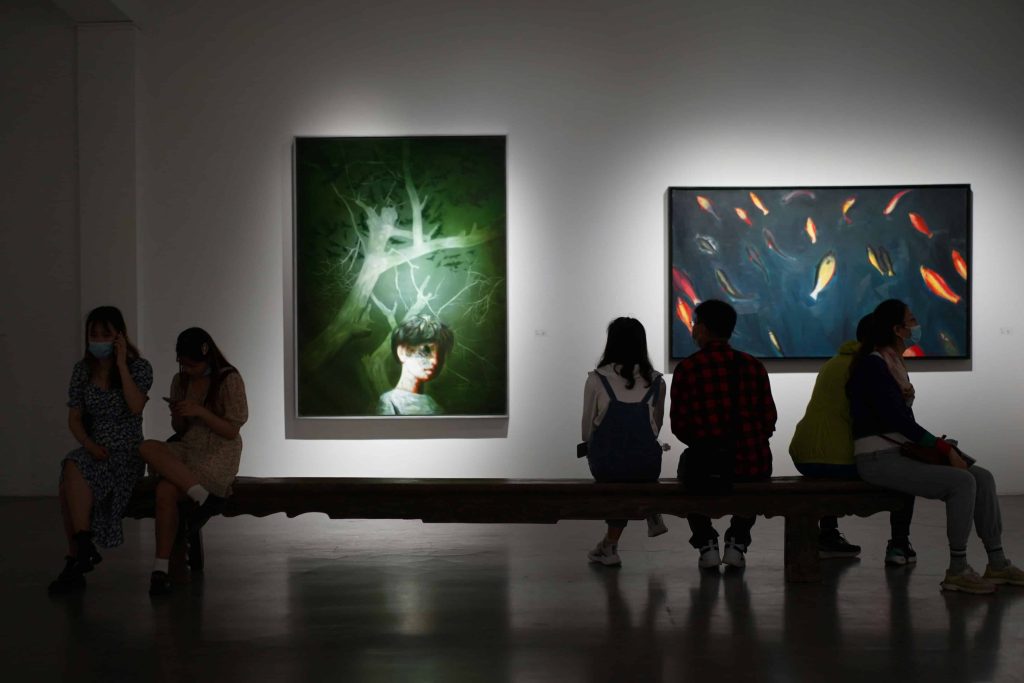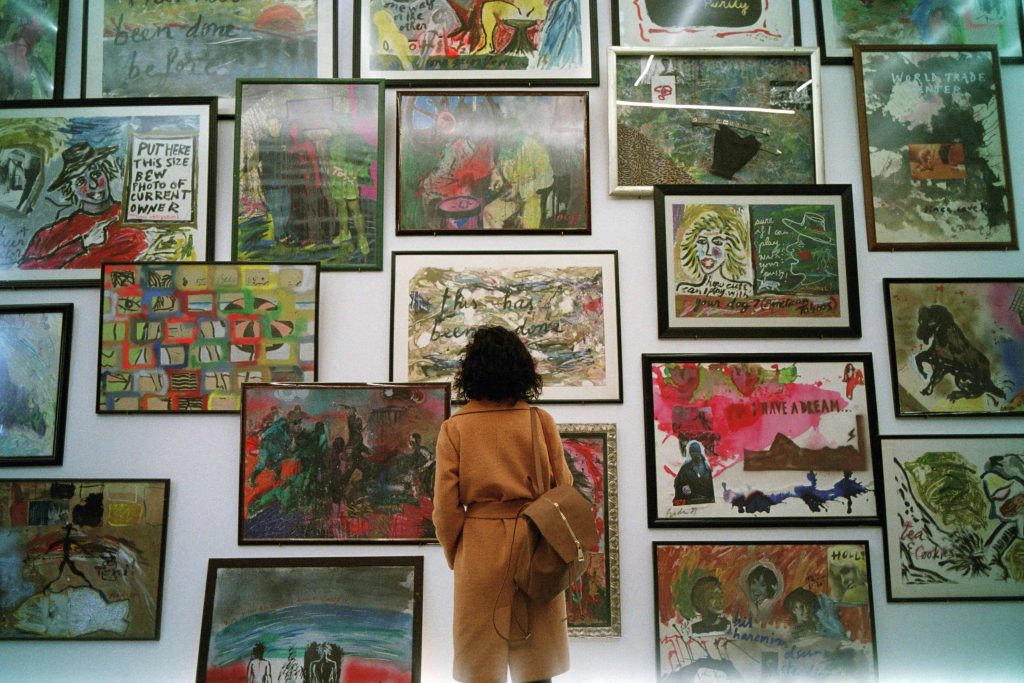
16 Apr Greener Galleries: Rethinking Sustainability in Art Exhibitions in 2025
Environmental Sustainability in Art Exhibitions
Environmental sustainability in art exhibitions refers to the conscious integration of eco-friendly practices throughout the planning, design, and execution of physical art displays. This approach seeks to minimize the environmental footprint of exhibitions without compromising the artistic and experiential value they offer to audiences. As the global art world becomes increasingly aware of its environmental responsibilities, institutions, curators, and artists are rethinking their practices to align with broader sustainability goals.
The urgency for adopting sustainable practices has grown as climate change, resource depletion, and environmental degradation continue to dominate global discourse. Art exhibitions, traditionally reliant on resource-intensive methods, are being scrutinized for their environmental impacts. From construction materials and energy usage to transportation and waste management, every aspect of a physical exhibition presents opportunities for more sustainable alternatives. This article explores how these practices can evolve and adapt, focusing specifically on the physical elements of exhibitions.
The Environmental Impact of Traditional Art Exhibitions
Traditional art exhibitions often involve high levels of resource consumption. Materials like plywood, plastics, and synthetic paints are frequently used to construct temporary walls, partitions, and display stands. These materials, while convenient and affordable, are rarely reused and often discarded after a single use. Lighting systems and climate control—essential for both visitor comfort and artwork preservation—consume vast amounts of energy, especially in large-scale or long-running exhibitions. Transportation of artworks, staff, and exhibition infrastructure further contributes to greenhouse gas emissions, particularly when international shipping is involved.
The carbon footprint of exhibitions extends beyond travel and electricity usage. Embodied carbon—the total greenhouse gas emissions associated with the lifecycle of materials—can be significant in exhibition components. For instance, a custom-built display stand may have a short operational life but leave a long-term environmental impact due to the production, transportation, and eventual disposal of its materials. These cumulative effects underscore the necessity of reevaluating standard exhibition practices through a sustainability lens.
Sustainable Material Choices and Construction
Choosing environmentally responsible materials is a critical step toward more sustainable exhibitions. Recycled and upcycled materials, such as reclaimed wood, repurposed metals, and recycled plastics, can replace conventional options while maintaining structural integrity and aesthetic appeal. Additionally, biodegradable materials like natural fibers or plant-based composites offer lower-impact alternatives, especially for temporary installations.
Modular design plays a significant role in sustainability. Modular systems allow for easy assembly, disassembly, and reconfiguration, enabling components to be reused across multiple exhibitions or venues. Efficient planning in the fabrication process reduces material waste by optimizing cuts and minimizing offcuts. Furthermore, sourcing materials from local or regional suppliers reduces the environmental costs associated with long-distance transportation. By embedding these principles into the design process from the outset, exhibitions can significantly lower their material footprint.
Energy Efficiency and Management
Energy use in exhibitions—particularly for lighting and climate control—can be substantial. Switching to energy-efficient LED lighting not only reduces power consumption but also generates less heat, alleviating the burden on air conditioning systems. Motion sensors and timed lighting schedules help minimize unnecessary energy usage by activating lights only when needed.
Optimizing HVAC (heating, ventilation, and air conditioning) systems to maintain appropriate temperature and humidity levels with minimal energy input is another key strategy. Integrating renewable energy sources, such as solar panels or wind turbines, into the exhibition venue’s infrastructure can further offset electricity demands. Conducting energy audits helps institutions identify inefficiencies and prioritize upgrades or behavioral changes that lead to long-term reductions in consumption.
Transportation and Logistics
Reducing the environmental impact of transportation involves rethinking the frequency and distance artworks travel. Exhibitions can be curated with more regional artists or feature locally available works, minimizing the need for long-haul shipping. When transportation is necessary, consolidating shipments, using low-emission vehicles, or choosing shipping providers with green credentials can reduce the overall carbon footprint.
Digital tools also offer valuable support in logistics. Virtual previews, condition reports, and digital catalogs can reduce the need for curators and technicians to travel for site visits or planning meetings. By relying on digital documentation, institutions can maintain high levels of communication and coordination without the environmental cost of physical travel.
Waste Reduction and Management
Art exhibitions generate various forms of waste, from packaging and promotional materials to construction debris. Effective waste management begins with reducing single-use materials. Wherever possible, reusable containers, tools, and signage should be prioritized. Compostable or recyclable materials can be used for programs, labels, and visitor handouts.
Designing components with disassembly and reuse in mind ensures they can be easily taken apart and repurposed or recycled after the exhibition. This approach also facilitates the sharing of components between institutions. Hazardous materials, such as certain paints or cleaning agents, should be minimized or substituted with safer alternatives. Additionally, using digital signage and mobile guides helps reduce paper waste and improves visitor engagement.

Audience Engagement and Education
Engaging audiences in sustainability efforts is essential for creating long-term cultural change. Exhibitions can incorporate educational elements that explain the sustainable choices made during their planning and construction. Signage, interactive displays, and digital content can highlight eco-friendly practices and inspire visitors to reflect on their own environmental impact.
Involving visitors in the sustainability dialogue also reinforces institutional transparency and accountability. Providing options for sustainable behavior—such as recycling stations, refillable water bottle facilities, or green transportation incentives—encourages active participation. Exhibitions that integrate environmental themes within their artistic content can go even further, using the platform to advocate for broader ecological awareness.
Future Directions and Innovations
The future of sustainable art exhibitions lies in innovation and collaboration. Advancements in material science are producing more sustainable building materials, such as mycelium-based boards and algae-derived plastics, which may soon be commonplace in exhibition design. Smart building technologies, which automate lighting, temperature control, and energy monitoring, are increasingly being integrated into exhibition venues to reduce resource use.
Collaboration between artists, curators, institutions, and suppliers is crucial for establishing new standards and driving industry-wide change. Shared resources, open-source design templates, and knowledge exchanges help spread best practices. Virtual and hybrid exhibitions, while not without their own environmental considerations, offer scalable ways to reduce the need for extensive travel and physical materials. As sustainability becomes a core value in the arts, institutions are poised to lead by example and shape a greener future for the cultural sector.
Conclusion
Sustainable practices in art exhibitions are no longer optional—they are essential for the long-term viability of both the art world and the planet. From material choices and energy management to logistics and audience engagement, every aspect of a physical exhibition presents opportunities for improvement. By adopting these strategies, institutions can significantly reduce their environmental impact while enriching the visitor experience and upholding artistic integrity.
As awareness grows and technology evolves, the tools and resources available for sustainable exhibition design will only become more accessible and effective. The path to sustainability is ongoing, requiring continuous learning, innovation, and commitment. Now more than ever, the art world has a unique opportunity—and responsibility—to embrace environmental sustainability and lead cultural transformation on a global scale.
Key Takeaways
- Environmental Impact of Traditional Exhibitions: Art exhibitions often rely on resource-heavy materials, high energy consumption, and transportation, contributing to substantial environmental harm. Sustainable alternatives are becoming increasingly necessary.
- Sustainable Material Choices: Using recycled, upcycled, and biodegradable materials, along with modular designs, can reduce waste and promote reuse. Sourcing local materials also helps minimize the carbon footprint.
- Energy Efficiency: Incorporating energy-efficient lighting, optimized HVAC systems, and renewable energy sources like solar panels can significantly reduce energy consumption in exhibitions.
- Transportation and Logistics: Minimizing artwork travel by using regional artists, consolidating shipments, and leveraging digital tools for logistics can lower emissions associated with transportation.
- Waste Reduction: Reducing single-use materials, promoting recycling, and using reusable or compostable materials for exhibition components and promotional items can minimize waste. Designing for easy disassembly ensures materials are repurposed or recycled.
- Audience Engagement: Educating visitors about sustainable practices and involving them in environmental efforts fosters cultural change. Transparent communication and options like recycling stations promote sustainable behaviors.
- Future Innovations: Advances in material science (e.g., mycelium-based materials) and smart building technologies, along with virtual and hybrid exhibitions, offer promising paths to reduce environmental impacts.
FAQs
Why is sustainability important in art exhibitions?
Sustainability in art exhibitions helps reduce the environmental impact of resource-intensive practices, such as excessive energy use, waste, and transportation emissions. By integrating eco-friendly materials and energy-efficient systems, art institutions can align with broader environmental goals while preserving the artistic integrity of the exhibitions.
How can exhibitions minimize their carbon footprint?
Exhibitions can minimize their carbon footprint by using recycled or biodegradable materials, optimizing energy efficiency with LED lighting and renewable energy sources, and reducing transportation distances. Additionally, modular designs and digital tools can further decrease waste and the environmental costs of exhibitions, contributing to a more sustainable approach.
How can audience engagement promote sustainability in exhibitions?
Audience engagement plays a critical role in promoting sustainability by educating visitors about eco-friendly practices through interactive displays, signage, and digital content. Offering sustainable options like recycling stations and green transportation incentives encourages visitors to actively participate, reinforcing the importance of environmental responsibility within the cultural sector.
From virtual reality to augmented experiences, discover how digital platforms are pushing the boundaries of creativity, making art more accessible and interactive than ever before.




